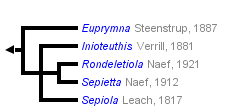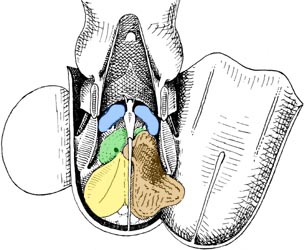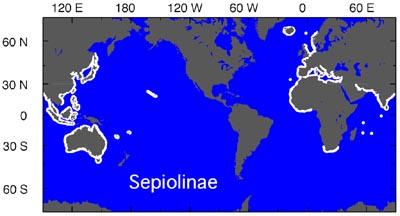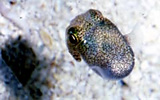Sepiolinae
Michael Vecchione and Richard E. Young


This tree diagram shows the relationships between several groups of organisms.
The root of the current tree connects the organisms featured in this tree to their containing group and the rest of the Tree of Life. The basal branching point in the tree represents the ancestor of the other groups in the tree. This ancestor diversified over time into several descendent subgroups, which are represented as internal nodes and terminal taxa to the right.

You can click on the root to travel down the Tree of Life all the way to the root of all Life, and you can click on the names of descendent subgroups to travel up the Tree of Life all the way to individual species.
For more information on ToL tree formatting, please see Interpreting the Tree or Classification. To learn more about phylogenetic trees, please visit our Phylogenetic Biology pages.
close boxIntroduction
Members of the Sepiolinae are neritic and benthic sepiolids. The subfamily has a world wide distribution except for waters of the Americas. Their highest diversity appears to be in the eastern Atlantic Ocean and Mediterranean Sea.
Brief diagnosis:
A sepiolid ...
- with dorsal mantle fused to head.
- without ventral mantle shield.
Characteristics
- Arms
- Interbrachial web weakly developed between arms I-III.
- Suckers in 2-4 series except at tip where there may be more.
- Left dorsal arm of male hectocotylized (see details under Comments below).
- Tentacles
- Tentacular clubs expanded.
- Keel along full length of club.
- Mantle
- Dorsal mantle fused to head.
- Gladius
- Gladius reduced or absent.
- Viscera
- Bursa copulatrix present near female genital opening.
- Photophores
- Photohores, when present, usually (see exception in Rondeletiola) with separate bean-shaped lenses and reflectors on lateral lobes of ink sac.
 Click on an image to view larger version & data in a new window
Click on an image to view larger version & data in a new window
Figure. Ventral view of the visceral photophores of Euprymna scolopes. Only the ends of the bean-shaped reflectors can be seen due to expansions of the ink sac over the mid-regions. The lenses that cover the reflectors are transparent and cannot be seen. © 2004 Richard E. Young


Figure. Ventral view of the mantle cavity of Sepiola robusta, mature female. Nidamental glands are colored yellow; the bursa copulatrix is colored brown. The photophores are blue. Note that the bursa extends over the base of the gill and onto the muscular mantle. Drawing modified from Naef (1921-23).
Comments
The Sepiolinae comprise two natural groups: Euprymna and the remaining Sepiola-like species. Eupyrmna is distinguished, among other features, by the presence of four sucker series on the arms and a hectocotylus (left arm I) that is less specialized in lacking a "copulatory apparatus." The Sepiola-like species have arm suckers in two series except at the tips of arms IV where more may be present and a distinct type of hectocotylus. The latter hectocotylus (left arm I) consists of 1-4 normal suckers at the base of the arm, followed by a "copulatory apparatus" that includes modified sucker stalks without suckers, followed by a relatively normal distal portion (Naef 1921-23).
A distinct feature of the Sepiolinae is the presence of the bursa copulatrix in females. This is a folded pocket of the lining of the mantle cavity near, and often covering, the oviducal opening but is not part of the latter which may have its own flutted lips. The bursa is an attachment site for spermatangia. Other sepiolids a wrinkled skin in this region and the bursa is a great elaboration of this wrinkled area (Naef, 1921-23).
The following table compares the genera of the Sepiolinae.
| Arm sucker series* | Visceral photophores | Club sucker series | Gladius | |
| Euprymna | 4** | Yes | >20** | Present |
| Inioteuthis | 2 | No | 8-16 | Absent |
| Rondeletiola | 2 | Yes | 8-16 | Absent |
| Sepietta | 2 | No | 16-32 | Very weak |
| Sepiola | 2 | Yes | <9 | Present |
**Except E. phenax (2 sucker series on arms, 12-14 on clubs).
Discussion of Phylogenetic Relationships
We follow the phylogeny of Naef (1921-23) with the exception that we place Sepiolina in the Heteroteuthinae.
Distribution
The subfamily does not occur in waters of the Americas. Young (et al., 1998) speculate that the group evolved after the shallow water bridge across the high North Atlantic was obliterated.
References
Naef, A. 1921-1923. Die Cephalopoden. Fauna e Flora del Golfo di Napoli, Monographie 35, Vol I, Parts I and II, Systematik, pp 1-863.
Young, R. E., M. Vecchione and D. Donovan. 1998. The evolution of coleoid cephalopods and their present biodiversity and ecology. South African Jour. Mar. Sci., 20: 393-420.
Title Illustrations

| Scientific Name | Euprymna scolopes |
|---|---|
| Location | Hawaiian waters |
| Specimen Condition | Live Specimen |
| View | Dorsolateral |
| Image Use |
 This media file is licensed under the Creative Commons Attribution-NonCommercial License - Version 3.0. This media file is licensed under the Creative Commons Attribution-NonCommercial License - Version 3.0.
|
| Copyright |
© 2004

|
About This Page

National Museum of Natural History, Washington, D. C. , USA

University of Hawaii, Honolulu, HI, USA
Correspondence regarding this page should be directed to Michael Vecchione at and Richard E. Young at
Page copyright © 2019 and
 Page: Tree of Life
Sepiolinae .
Authored by
Michael Vecchione and Richard E. Young.
The TEXT of this page is licensed under the
Creative Commons Attribution-NonCommercial License - Version 3.0. Note that images and other media
featured on this page are each governed by their own license, and they may or may not be available
for reuse. Click on an image or a media link to access the media data window, which provides the
relevant licensing information. For the general terms and conditions of ToL material reuse and
redistribution, please see the Tree of Life Copyright
Policies.
Page: Tree of Life
Sepiolinae .
Authored by
Michael Vecchione and Richard E. Young.
The TEXT of this page is licensed under the
Creative Commons Attribution-NonCommercial License - Version 3.0. Note that images and other media
featured on this page are each governed by their own license, and they may or may not be available
for reuse. Click on an image or a media link to access the media data window, which provides the
relevant licensing information. For the general terms and conditions of ToL material reuse and
redistribution, please see the Tree of Life Copyright
Policies.
- First online 30 August 2004
Citing this page:
Vecchione, Michael and Richard E. Young. 2004. Sepiolinae . Version 30 August 2004 (under construction). http://tolweb.org/Sepiolinae/20035/2004.08.30 in The Tree of Life Web Project, http://tolweb.org/








 Go to quick links
Go to quick search
Go to navigation for this section of the ToL site
Go to detailed links for the ToL site
Go to quick links
Go to quick search
Go to navigation for this section of the ToL site
Go to detailed links for the ToL site